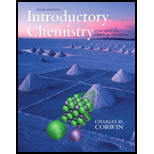
Concept explainers
Interpretation:
Among
Concept introduction:
Intermolecular forces are considered as the forces that exist between the atoms, molecules and ions. These forces are attractive as well as repulsive in nature. The bonding in which the hydrogen atom is directly attached to an electronegative atom is known as hydrogen bonding.
Answer to Problem 1CE
The compound that has the stronger intermolecular attraction is
Explanation of Solution
The hydrogen bonding is the strongest intermolecular force of attraction that exists between the species having huge difference in their polarity. The compound,
The compound,
Want to see more full solutions like this?
Chapter 11 Solutions
Introductory Chemistry: Concepts And Critical Thinking, Books A La Carte Edition (8th Edition)
- Predict which liquid—glycerol, HOCH2CH(OH)CH2OH, or hexane, C6H14—has the greater surface tension. Explain your prediction.arrow_forward5-106 The normal boiling point of hexane, C6H14, is 69°C, and that of pentane, C5H12, is 36°C. Predict which of these compounds has a higher vapor pressure at 20°C.arrow_forwardIntermolecular forces: What type of forces must be overcome between I2 molecules when solid I2 dissolves in methanol, CH3OH? What type of forces must be disrupted between CH3OH molecules when I2 dissolves? What type of forces exist between I2 and CH3OH molecules in solution?arrow_forward
- What is the predominant intermolecular force acting between molecules in a mixture of CCl4 and CH3OH.arrow_forwardWhich of the following substances will have the greatest vapor pressure at 0°C? CH4 MgO ammonia NaCl waterarrow_forwardName four type of intermolecular forces which stabilize 2° and 3° structure of proteins.arrow_forward
- Which of the following has the highest boiling point? a. 0.1M CH3OH, c. 0.1M glucose e. 0.1M AlCl3 b. 0.1M LiOH d. 0.1M calcium phosphate f. 0.1M Mg(NO3)arrow_forwardName the intermolecular forces that mustbe overcome to convert the followingspecies from a liquid to a gas. Liquid oxygen (O2) Methyl iodide (CH3I) Ethanol (C2H5OH)arrow_forwardWhich one of the following substances would be the most soluble in CCI4? C5H12 HI NaNO3 NH3 CH3OHarrow_forward
- Name the STRONGEST intermolecular force between the two molecules NaCl and H2O.arrow_forward6. If the molality of the following compounds is the same, which compound will have the highest boiling point in water is...... (A) CaCl2 (B) NaBr (C) CuSO4 (D) CH3OH (E) KNO3arrow_forwardWhat is the respiration rate for a breath every 2.5 seconds? What solids are made up of large numbers of independent, constituent units, some of which attract and others repel.arrow_forward
 Principles of Modern ChemistryChemistryISBN:9781305079113Author:David W. Oxtoby, H. Pat Gillis, Laurie J. ButlerPublisher:Cengage Learning
Principles of Modern ChemistryChemistryISBN:9781305079113Author:David W. Oxtoby, H. Pat Gillis, Laurie J. ButlerPublisher:Cengage Learning World of Chemistry, 3rd editionChemistryISBN:9781133109655Author:Steven S. Zumdahl, Susan L. Zumdahl, Donald J. DeCostePublisher:Brooks / Cole / Cengage Learning
World of Chemistry, 3rd editionChemistryISBN:9781133109655Author:Steven S. Zumdahl, Susan L. Zumdahl, Donald J. DeCostePublisher:Brooks / Cole / Cengage Learning Chemistry & Chemical ReactivityChemistryISBN:9781337399074Author:John C. Kotz, Paul M. Treichel, John Townsend, David TreichelPublisher:Cengage Learning
Chemistry & Chemical ReactivityChemistryISBN:9781337399074Author:John C. Kotz, Paul M. Treichel, John Townsend, David TreichelPublisher:Cengage Learning Chemistry & Chemical ReactivityChemistryISBN:9781133949640Author:John C. Kotz, Paul M. Treichel, John Townsend, David TreichelPublisher:Cengage Learning
Chemistry & Chemical ReactivityChemistryISBN:9781133949640Author:John C. Kotz, Paul M. Treichel, John Townsend, David TreichelPublisher:Cengage Learning Chemistry: Principles and ReactionsChemistryISBN:9781305079373Author:William L. Masterton, Cecile N. HurleyPublisher:Cengage Learning
Chemistry: Principles and ReactionsChemistryISBN:9781305079373Author:William L. Masterton, Cecile N. HurleyPublisher:Cengage Learning Introduction to General, Organic and BiochemistryChemistryISBN:9781285869759Author:Frederick A. Bettelheim, William H. Brown, Mary K. Campbell, Shawn O. Farrell, Omar TorresPublisher:Cengage Learning
Introduction to General, Organic and BiochemistryChemistryISBN:9781285869759Author:Frederick A. Bettelheim, William H. Brown, Mary K. Campbell, Shawn O. Farrell, Omar TorresPublisher:Cengage Learning





